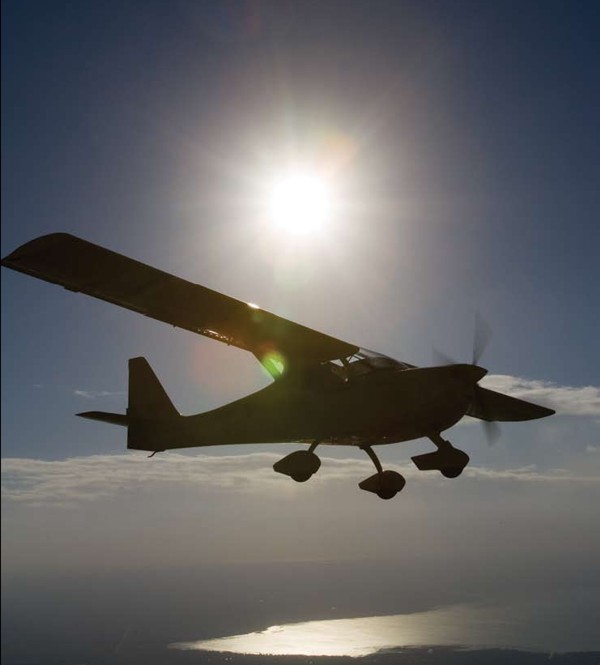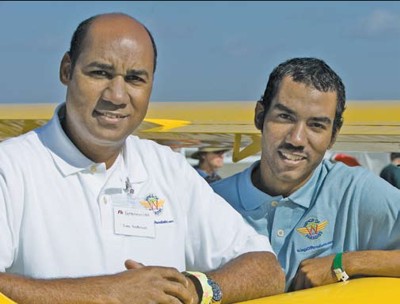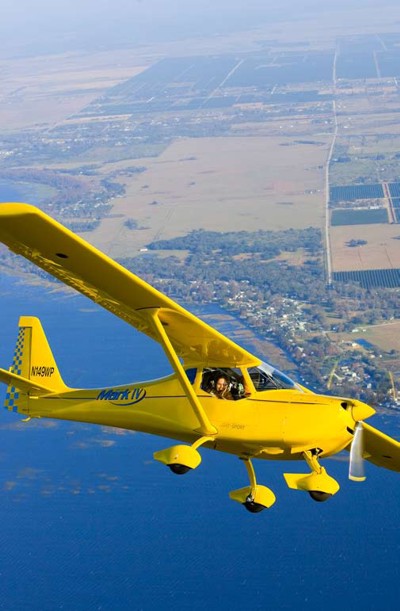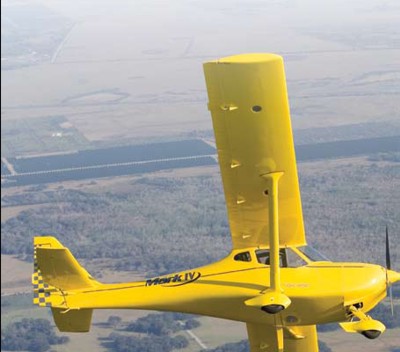

Tony Anderson, left, and his son Adriel lead Fk-Lightplanes USA, based on North Perry Airport in Pembroke
Pines, Florida. Tony has been active in ultralight and light-sport aviation for years, previously
a flight school in the Miami area. They’ve now teamed with Fk-Lightplanes of Germany to import the
Fk line of aircraft into the U.S., with the Fk9 leading the parade.

Fk-Lightplanes’ Fk9 features a carbon fiber
fuselage with a chromoly steel cockpit cage.
The wings are carbon fiber, except that all
control surfaces–including the empennage–
are aluminum.


Panel With a center stick for pilot and passenger, dual throttles, and dual rudder pedals, the Fk9 is set up for training. At about 42 inches wide, the 9’s cockpit is
narrower than some LSA, but its efficiently designed. Leather seats are an option for those wanting to dress up their plane. (Courtesy Fk-Lightplanes USA)

Handles A grip for the hydraulic brakes for mains provides a tactile differentiation for that control versus the trim lever, also in the center console. A mechanical flap
handle alongside the center console deploys the flaps while an LED light on the panel shows the flap position.

Seats A three-point shoulder harness/seat belt is standard as are two-tone seats A baggage compartment is located behind the seats for easy access in flight.

Wings Side View Tony will import only the folding wing version of the 100-hp Fk9. However, individuals may order a non-folding wing airplane and/or an 80-hp
version|if they’re willing to wait a bit longer for the aircraft. The Fk9 is also available as a tail dragger, with a float option. Most of the aircraft Tony will import will be
tri-geared airplanes, with a few tail draggers for pilots who prefer that configuration.

Wing Fold. The wing folding mechanism up close and personal. The wing reportedly can be folded easily by one individuals. Simply pull the lever
on the wingtip and swing the wing down and back along the side of the fuselage.

Wing fold Lever.

Following Henry Ford’s example to keep production
simple, you can have the Fk9 in any
color you want…as long as its yellow or white
for now. With 300 aircraft delivered, the design
is richer in history than many other LSA,
but that doesn’t mean production efficiencies
don’t make sense. While the airplane is available
as a tail dragger or tri-gear, Fk-Lightplanes
USA has pre-ordered mostly tri-gear
airplanes, anticipating that most U.S. buyers
will favor that configuration. Tail dragger enthusiasts
may special order that version.

This airplane began life under
B&F Technik Vertriebs GmbH,
a name derived from partners
Dirk Breitkreuz and Peter Funk, who
started the commercial enterprise.
Now, Funk operates the company on
his own and has adopted the worldlier
and less cumbersome name Fk-
Leichtflugzeuge, its English translation
being Fk-Lightplanes. U.S.
distributor Tony Anderson named
his enterprise Fk-Lightplanes USA.
Based in Pembroke Pines, Florida,
Fk-Lightplanes USA calls North Perry
Airport home.
The Funk name is storied in European
light aircraft development,
with more than a dozen original designs
to its credit. Fk-Lightplanes today
produces three airplanes, each
quite different from the other: our
subject airplane this month-the
high-wing Fk9, the low-wing Fk14
Polaris, and a folding-wing biplane
called the Fk12 Comet. I’ve had the
pleasure of flying all three models,
but I think the Fk9 may prove most
popular with American LSA enthusiasts.
Though designed and refined in
Speyer, Germany, the Fk9 and its siblings
are now fabricated in Poland by
workers with decades of experience
building Soviet fighters and transports.
In June 2006 Fk-Lightplanes
delivered Fk9 serial number 300 to a
German flight school, its second Fk9
for training and rental. On the occasion
of this sale, Funk announced
the company would double its production
output to meet rising demand,
some of which is now developing
in the United States.
The Fk9 Evolution
With 300 aircraft delivered, the design
is richer in history than many other
LSA. It is also a well-evolved aircraft.
Its “Mark IV” designation indicates
this is the fourth model of this airplane.
The Fk9’s steel tube fuselage started
out as fabric-covered and progressed through a series of improvements to
the present-day composite-covered
airplane. Funk likes the crashworthiness
of the steel tube structure in
combination with the resistance to
corrosion offered by the composite
covering.
Fk9’s tail plane is constructed of
aluminum, while the landing gear
is a carbon fiber and steel combination-
in either a nose-wheel or tailwheel
configuration. The wings are
carbon fiber, except that all control
surfaces are aluminum structure with
fabric covering.
The Mark III iteration of the Fk9
added an optional folding wing, a
feature that has reportedly sold many
aircraft for companies like Kitfox Aircraft
or the Kolb Company. But the
Fk9’s folding wing is very user-friendly;
one person can handle the task
in minutes. I’ve never seen a more
efficient wing-folding system. After
removing some fairing sections from
the strut, you simply move a lever at
the wingtip and fold the wing aft in
mere minutes. Given the shortage and
cost of hangars at many airports, this
option offers owners the opportunity
to reduce costs by sharing a hangar or
trailering the airplane home.
Recently, Fk-Lightplanes shortened
the Mark IV’s wing by about 2 feet (to
29.9 feet from 32.3 feet) and designated
that model the Fk9 B Mark IV. This
short-wing version was certified in
Germany with slotted flaps. Fk-Lightplanes
said this also shaved about 9
pounds from the airplanes’ empty
weight, resulting in an increased payload
and slightly better performance.
The shorter wing reportedly is also
less sensitive in turbulence, and the
landing flare has been made easier.
Improved stability in this model
comes from optimized controls. Fk-
Lightplanes said an enlarged vertical
tail fin and some tweaking of the
flap settings made handling more
straightforward, even at lower landing
speeds. The company believes this
will enhance the airplane’s appeal to
flight-training operations.
The clipped-wing Fk9 B needed an
increased angle of incidence, demanding
a new fuselage mold. A side benefit
of this change is improved forward
visibility, which had been criticized
on earlier versions of the Fk9.
First-Class Cabin
The high-wing Fk9 features side-byside
seating, and each occupant can
enter easily through gull-wing-style
doors that open upward, with gasdriven
springs holding the doors
open. With the Mark IV, the door was
widened to further ease entry; the
extra space is at the front-lower corner
of the door, which helps bring in
your legs and feet.
At 42 inches wide, the Fk9’s cabin is
similar to a Cessna 172. Average-sized
occupants will just touch one another’s
shoulder, though larger American
pilots will find the Fk9 snugger than
some LSA. Everyone will appreciate
the quality finish of the cockpit. The
Mark IV’s door is nicely formed to
provide an armrest and a handgrip.
Its closing latch works solidly.
Both pilot and copilot have a lefthand
throttle (on the panel) and individual
right-hand joysticks, a natural
feel for the majority of pilots. There’s
no handrest or armrest for the rightseat
pilot, which may cause arm fatigue,
but the left-seat pilot can use
the left-door armrest. Most other
ergonomic factors of the cockpit appeared
well considered.
The Fk9 I flew had an electronic
instrument that offered much useful
information, including fuel flow.
It was a European instrument, but
Americans can select from many U.S.
electronic information systems.
On the Fk9, the main wheel hydraulic
brakes are operated by a centrally
located control. The grip is secure
for either pilot, and the brakes
proved to be quite strong.
The Fk9 I flew had a skylight window,
which added considerably to
visibility during turns. At my average
height, I didn’t have to lower my
head to see laterally under the wing.
It was also surprisingly quiet inside.
Clearly Fk-Lightplanes invested
extra effort to dampen noise in the
cockpit. When I took my headset
off, I noticed more wind noise than
engine noise in cruise. It was much
quieter than many general aviation
airplanes I’ve flown. Led by German
laws, European standards limit
noise to 55 dB at full power at about
500 feet AGL-no louder than ordinary
conversation. That makes the
airplane’s occupants as happy as the
neighbors below.
Light and Responsive
I’ve test flown the Fk9 twice: first with
the 80-hp Rotax 912 engine and, most
recently, behind the 100-hp 912S
with American distributor Tony Anderson.
Both times, the airplane had
the longer wing. (Tony will import
only the shorter wing 100-hp model
with the folding wing option.)
The factory was experimenting
with various prop configurations on
the 80-hp version when I flew it, and
the prop was not optimally pitched.
Consequently, climb performance
wasn’t quite as strong as it could be;
we averaged about 800 fpm. That
prop configuration also affected
engine performance; the tachometer
never indicated more than 4,700
rpm, though it should have been in
the 5000-plus rpm. Naturally this affected
cruise a bit, too.
With the 100-hp 912S, Tony suggested
one notch of flaps for takeoff,
and climb improved to about 1,000
fpm. The two position flaps-5 and
30 degrees-are actuated via a center
console-mounted mechanical lever.
An LED light on the panel shows the
flap position. The 100-hp Rotax 912S
reportedly lifts the new B-model shortwing
Fk9 much more enthusiastically,
at about 1,500 fpm. This is the powerplant/
configuration most Americans
will buy, so climb, even in higher density
altitudes, will be strong.
I found the Fk9 to have a light
control feel that reminded me of
Kitfox aircraft. I also found the rudder
a little more sensitive than the
ailerons. But I adapted, and I believe
most pilots will do likewise. Most
LSA handle more like sport cars
when compared to the sedan feel of
a Cessna 172.
Commensurate with that sports
car feel, the Mark IV Fk9 offers fingertip flying. It took a little time
to coordinate turns, as I was having
some difficulty keeping the ball
centered at first. The rudder is also
quite responsive.
The Fk9’s roll rate is pleasantly
quick; I’d estimate its 45-to-45 degree
roll reversal time was about
one and a half seconds. Both the
ailerons and elevator are mass balanced,
with the aileron mass disappearing
neatly inside a specially
made cavity at the wingtip, an example
of German design and workmanship.
After a few series of Dutch-roll coordination
exercises, I gained a better
feel for the Fk9’s handling and
was able to perform steep turns at
60 degrees. It seems the Fk9 loves to
maneuver and won’t wear you out.
With the 912S, we held 100 mph
at an economy cruise rate of 3 gallons
an hour. The Fk9 can reach a
120-mph (104 knots) top cruising
speed at 75 percent power. At full
power in the 80-hp model, I saw a
fuel burn rate of 3.5 gallons, much
less than even an underpowered
Cessna 150 could manage. Some
LSA cruise a bit faster, but few can
improve on the Fk9’s economy.
None of the stalls I performed
in Fk9 produced a stall break, even
with the stick all the way aft. During
stalls, the nose showed no tendency
to wander. Overall, the Fk9
felt solid, though I had the benefit
of flying in smooth air.
On landing, Tony advised a single
notch of flaps with an approach
speed of about 60 mph. You can approach
somewhat slower with more
flaps, but even at a minimal setting
I found Fk9’s landing to be straightforward.
Have It Your Way
Pricewise, the Fk9 falls about in the
middle of the S-LSA range. In the
fall of 2006, the basic Fk9 with the
80-hp Rotax 912 listed for $75,800.
That model will be available in
Europe; however, Fk-Lightplanes
USA plans to import all short-wing
models (the Fk9 B) with the folding
wing and the 100-hp Rotax 912S as
standard equipment. Tony believes
that’s what the U.S. market will
prefer, and ordering standard models
helps the factory maintain production
efficiency. American buyers
will be able to special order the
80-hp 912 model, but they’ll have
to wait longer for delivery.
The 912S-powered short-wing
model will list for $89,000, before
radio and avionics packages are
added. Standard components will
include airspeed indicator, altimeter,
compass, slip indicator, oil
pressure and temperature gauges,
cylinder head temperature (CHT)
gauge, tachometer, hydraulic drum
brakes, two-tone seat cushions, mechanical
elevator trim, electronic
flap position indicator, and 16-gallon
fuel tank with electronic level
indicator. The standard color is
white with standard paint accents.
The Fk9 is available either as a
tricycle-gear or taildragger airplane,
but Tony has opted to import more
tricycle-gear models. The taildragger
version is, however, the one
adapted to floats, so Tony will have
a few in his inventory. But, buyers
will need to keep in mind that insurance
could be more challenging
to obtain for a taildragger.
An unusual feature under the
“Price and Options” heading on
the Fk-Lightplanes USA website
(www.Fk-LightplanesUSA.com) allows
potential buyers to view the
available options clearly priced,
with each one assigned a weight
value. That “configurator” allows
buyers to see how their choices affect
useful load and payload while
it subtotals their purchase price as
they add options. For example, an
optional 5-gallon wing tank can be
added to the standard 16-gallon
tank. It is priced at $1,239 and adds
8 pounds of weight, not including
the additional 30 pounds of fuel.
Cabin heating adds $600 and 2-1/2
pounds, but it will lengthen the
flying season for pilots in northern
climates.
Given the Fk9’s long history and
its list of desirable attributes, I think
Fk-Lightplanes USA may find a tidy
business selling this attractive high
wing. The Fk9 is a fine example
of a light aircraft resulting from
experienced western engineering
combined with eastern European
low-cost, highly skilled labor. The
Fk9’s agile flight qualities show the
designer didn’t forget the fun part.
I encourage a demo flight at your
earliest convenience.
| Empty weight | 636 pounds 1 |
| Gross weight | 1,250 pounds |
| Wingspan | 29.9 feet |
| Wing area | 112 square feet |
| Useful Load | 614 pounds |
| Length | 19.5 feet |
| Payload (with full fuel) | 518 pounds |
| Width | 6 feet (Wing-fold option) |
| Height | 7.9 feet |
| Fuel Capacity | 16 gallons |
| Airworthiness | Certified SLSA |
| Notes: | 1 *With the Rotax 912S and loaded with options; Fk9s coming to the USA, all with the Rotax 912S, reportedly have average weights of 600-615 pounds. |
| Standard engine | Rotax 912S |
| Power | 100 hp |
| Cruise speed | 124 mph |
| Stall Speed (Flaps) | 39 mph |
| Never exceed speed | 143 mph |
| Rate of climb at gross | 1,500 fpm |
| Takeoff distance at gross | 328 feet |
| Landing distance at gross | 375 feet |
| Range (powered) | 500 miles |


Leave a Reply